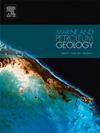Asymmetric oceanic crustal accretion and mantle serpentinization in the southwestern propagator tip of the South China Sea basin
IF 3.7
2区 地球科学
Q1 GEOSCIENCES, MULTIDISCIPLINARY
引用次数: 0
Abstract
A multi-channel seismic profile crossing the conjugate continental margins at the southwestern propagator tip of the South China Sea unveils asymmetric crustal structures. The southern margin exhibits rapid necking of the continental crust, while the northern margin features hyper-thinned crust controlled by detachment faults. The northern margin has thicker syn-rift deposits, while in the most distal parts of the southern margin, these deposits become thin or vanish entirely. Notably, the oceanic crustal structure is also asymmetric with respect to the spreading center. North of the spreading center, the oceanic crust is only 2–3 km thick, whereas to the south it is ∼5 km thick. Two sub-horizontal intra-basement reflections are identified in the northern oceanic domain, one representing the interface between basaltic oceanic crust and serpentinized mantle, and the second from gabbroic intrusions. Joint inversion of gravity, magnetic, and seismic data supports the presence of a highly serpentinized mantle beneath the thin oceanic crust. The reduced melting at the ridge-segment end may explain the observed asymmetrical rifting and seafloor spreading.
求助全文
约1分钟内获得全文
求助全文
来源期刊

Marine and Petroleum Geology
地学-地球科学综合
CiteScore
8.80
自引率
14.30%
发文量
475
审稿时长
63 days
期刊介绍:
Marine and Petroleum Geology is the pre-eminent international forum for the exchange of multidisciplinary concepts, interpretations and techniques for all concerned with marine and petroleum geology in industry, government and academia. Rapid bimonthly publication allows early communications of papers or short communications to the geoscience community.
Marine and Petroleum Geology is essential reading for geologists, geophysicists and explorationists in industry, government and academia working in the following areas: marine geology; basin analysis and evaluation; organic geochemistry; reserve/resource estimation; seismic stratigraphy; thermal models of basic evolution; sedimentary geology; continental margins; geophysical interpretation; structural geology/tectonics; formation evaluation techniques; well logging.
 求助内容:
求助内容: 应助结果提醒方式:
应助结果提醒方式:


